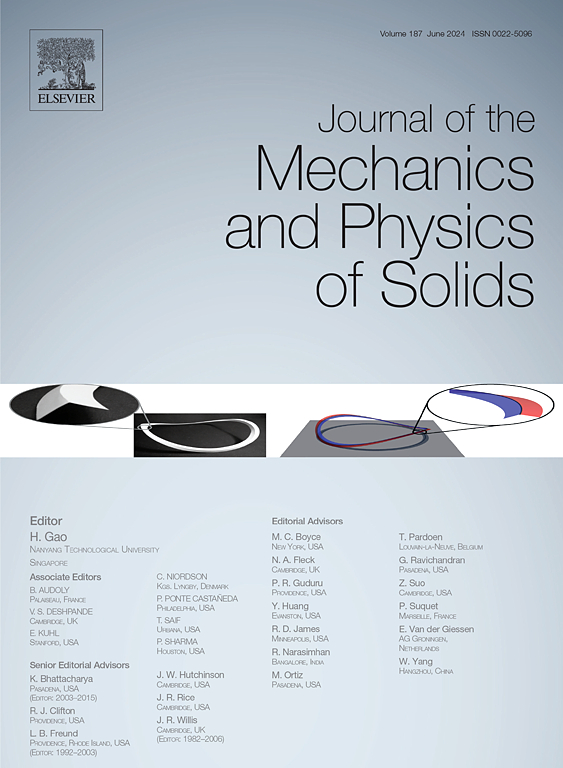具有横向各向同性半软弹性的向列弹性体的扩展新古典模型
IF 5
2区 工程技术
Q2 MATERIALS SCIENCE, MULTIDISCIPLINARY
引用次数: 0
摘要
由于液晶介介体和聚合物网络的耦合作用,向列弹性体表现出横向各向同性半软弹性。现有的本构模型无法同时捕捉小变形时的弹性各向异性和大正交加载时的半软应力平台。基于应变能和变形梯度的分解,提出了向列弹性体的扩展新古典模型,该模型由横向各向同性软弹性能和液晶导向器自由旋转的半软惩罚组成。该模型包含四个与温度相关的材料参数,可以通过实验确定。阐述了用热-力学实验确定材料参数的方法。在实验和理论研究的基础上,将材料参数对温度的依赖关系归纳为经验公式。分析和数值算例表明,该模型既能捕捉到小变形时的横向各向同性弹性,也能捕捉到大变形时应力诱导的大剪切变形方向旋转。本文章由计算机程序翻译,如有差异,请以英文原文为准。
An extended neo-classical model for nematic elastomers with transversely isotropic semisoft elasticity
Nematic elastomers exhibit transversely isotropic semisoft elasticity due to the coupling of the liquid crystal mesogen and polymer network. Existing constitutive models are unable to simultaneously capture both the elastic anisotropy at small deformations and the semisoft stress plateau under large orthogonal loadings. Based on the decompositions of the strain energy and the deformation gradient, we propose an extended neo-classical model for nematic elastomers, which consists of a transversely isotropic soft elastic energy plus a semisoft penalty for the free rotation of the liquid crystal director. The proposed model contains four temperature-dependent material parameters that can be determined through experiments. The determination of the material parameters by thermal-mechanical experiments is illustrated. Also, the temperature dependences of the material parameters are summarized into empirical formulae based on experimental and theoretical studies. Analytical and numerical examples are given to demonstrate that the proposed model can capture both the transversely isotropic elasticity at the small deformations and the stress-induced director rotations with large shear deformations at larger deformations.
求助全文
通过发布文献求助,成功后即可免费获取论文全文。
去求助
来源期刊
CiteScore
9.80
自引率
9.40%
发文量
276
审稿时长
52 days
期刊介绍:
The aim of Journal of The Mechanics and Physics of Solids is to publish research of the highest quality and of lasting significance on the mechanics of solids. The scope is broad, from fundamental concepts in mechanics to the analysis of novel phenomena and applications. Solids are interpreted broadly to include both hard and soft materials as well as natural and synthetic structures. The approach can be theoretical, experimental or computational.This research activity sits within engineering science and the allied areas of applied mathematics, materials science, bio-mechanics, applied physics, and geophysics.
The Journal was founded in 1952 by Rodney Hill, who was its Editor-in-Chief until 1968. The topics of interest to the Journal evolve with developments in the subject but its basic ethos remains the same: to publish research of the highest quality relating to the mechanics of solids. Thus, emphasis is placed on the development of fundamental concepts of mechanics and novel applications of these concepts based on theoretical, experimental or computational approaches, drawing upon the various branches of engineering science and the allied areas within applied mathematics, materials science, structural engineering, applied physics, and geophysics.
The main purpose of the Journal is to foster scientific understanding of the processes of deformation and mechanical failure of all solid materials, both technological and natural, and the connections between these processes and their underlying physical mechanisms. In this sense, the content of the Journal should reflect the current state of the discipline in analysis, experimental observation, and numerical simulation. In the interest of achieving this goal, authors are encouraged to consider the significance of their contributions for the field of mechanics and the implications of their results, in addition to describing the details of their work.

 求助内容:
求助内容: 应助结果提醒方式:
应助结果提醒方式:


